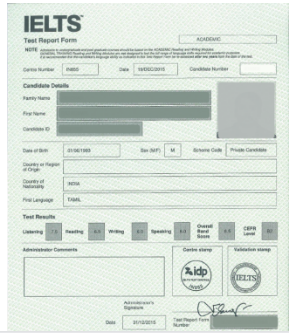
In this post, we are going to explain each part of the Academic Reading test and give you some tips on how to succeed. When you understand the test format of IELTS you are at an advantage.
Let’s start by reviewing some general information:
The IELTS exam tests your language ability through four different skills: Reading, Writing, Speaking, and Listening. You will take the exam in the following order: Listening, Reading, and Writing. Remember that there are no breaks between these tests. The Speaking test can be on the same day or a different one. All skills have the same value when it comes to marking the exam.
The IELTS Academic Reading is different from the IELTS General Reading.
The Reading consists of three long texts divided into 3 sections with a total of 40 questions. The texts are normally authentic and are taken from magazines, books, or newspapers. They range from being descriptive and factual to discursive and analytical. To complete the exam, you have 1 hour, and each question is awarded one mark.
To succeed in the Reading test, there are a few things that are important to know:
You need Reading strategies! During the test you are expected to be familiar with the following skills:
- read to get a general sense of a passage
- read for the main ideas
- read for detail
- understand inferences and implied meaning
- recognise a writer’s opinions, attitudes, and purpose
- follow the development of an argument
The next thing that is significant is to understand and be familiar with the different types of questions that you will find during the exam. The information you must search for in a gap-fill exercise is different from the information you need when completing a heading-matching exercise. We will have a look at some examples in a moment.
One more relevant thing to consider before taking your exam is that IELTS assesses your English level, which can range from an A1 beginner to a C2 advance. It is recommended that you know the level of English you have and what band you are aiming for. We´ll also explain the bands in a moment.
English levels


Here you have some of the basic information we´ve just explained:
FORMAT
3 sections with one long text in each one.
QUESTIONS
40
TIME
60 minutes.
MARKS
- Each correct answer receives one mark.
- 40 possible marks.
- Scores will be converted to the IELTS band scale.
TYPE OF QUESTIONS
- Multiple-choice questions.
- Matching headings to the paragraphs.
- Gap filling.
- Identifying writer’s views – Yes/no/not given.
- Identifying information – True/false/ not given.
- Sentence completion tasks.
- Short-answer questions.
- Chart, table, or diagram completion tasks.
READING SKILLS THAT ARE TESTED
- Read for the general sense of a passage.
- Read for the main ideas.
- Read for detail.
- Understand inferences and implied meaning.
- Recognise a writer’s. opinions, attitudes, and purpose.
- Follow the development of an argument.

In the IELTS Academic Reading, there are 3 texts, that can range from being descriptive and factual to discursive and analytical. Some of the texts may contain images such as diagrams, graphs, or illustrations. Topics are of general interest though they will usually coincide with one of the IELTS themes. This does not mean that you could be asked about something different, but that most probably they will talk about one of the following topics:
- Education
- Diet, Fitness, and Health
- Science
- Work
- Technology
- Advertising
- Culture and Society
- Environment
- Crime
- Learning languages
- The Arts
- Sports
- Money
- Travel and Transport
Now, let’s look at an example, remember there are 3 sections, with one long text in each. Normally each section will have 12 to 13 questions with different formats.
When doing an exam, time management is essential to succeed. We recommend that you:
- Spend a maximum of 15 minutes reading the texts
- Spend 1 min on each question: 40 questions = 40 minutes
- Leave 5 minutes at the end to check your exam.
15 min. Reading
Reading
+ 40 min
40 questions
+ 5 min
Checking
= 1hr
Use no more than one minute per question

Don’t start reading the text before looking at the tasks. When you start reading, you should do so with some questions in mind.
Remember that this isn’t a vocabulary test! Don’t panic if you come across unknown words.
Read the task carefully. Whenever you start doing a task, make sure you read the instructions and the examples carefully.
Practice by doing lots of reading tests. This is the best way to use your time before the exam!
Get better at scanning. Scanning is a reading method that allows you to find information faster. When scanning, you don’t read every single word, instead, you look for specific pieces of information.
Don’t try to understand the whole text. Getting a general gist of the text can be enough.
Key words. Finding key words will help you find the answer more quickly.
Leave difficult questions for the end. If you spend a lot of time on questions that you find difficult, you’ll be wasting valuable exam time.
Following these tips will help ensure that you find all of the correct answers while completing the exam within the 60 minutes.
In the exam, the 3 types of questions could come in many different styles, so it is recommended that you practice all these styles before attempting the exam.
Questions could be of the following:
- Identifying writer’s views – Yes/no/not given
- Identifying information – True/false/ not given
- Multiple choice questions – A, B, C, or D (sometimes more)
- Matching tasks – Connecting the questions to the reading or matching the headings to the paragraphs
- Gap filling tasks – Complete the space in the sentence with a word
- Sentence completion tasks – Complete the sentence with the appropriate words
- Short-answer questions – Write an answer to the questions in a certain amount of words
- Chart, table, or diagram completion tasks – Answering questions about the images or labeling what the images show
Remember that the Reading is corrected according to bands. Those bands correspond to different levels. Basically, your scores will depend on the number of correct answers that you have. A Band Score conversion table is produced for each version of the Academic Reading test, which translates scores out of 40 into the IELTS 9-band scale (1 to 9). Scores are reported in whole bands and half bands.
As we said earlier, each band corresponds to a level of English.


The Academic Reading test is marked by certified markers. All answer sheets are further assessed by Cambridge Assessment English. Depending on the number of correct answers you will achieve a different band score. Here you have a table on how to calculate your result.
If you need more information click HERE.
You can preview your results before receiving your certificate. The number of days will depend on which exam you decide to take.
- Paper-based test: 13 days from the exam date.
- Computer-delivered test: 3 to 5 days from the exam date.
Our Test Report Form (TRF), will be sent to you via mail, 13 days after the paper-based and 3 to 5 days after the computer-delivered. The delivery might take up to 7 working days, so remember that you can preview the results before receiving the certificate.

To improve, you can use some of these materials:
Books:


This platform allows online practice on any device.
IELTS OFFICIAL
If you need more information, or you want a professional teacher to help you achieve your goal, please contact us!

If you need extra help, just contact us!

